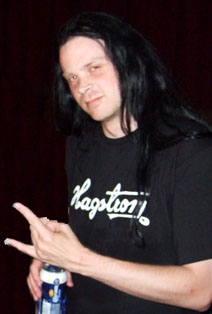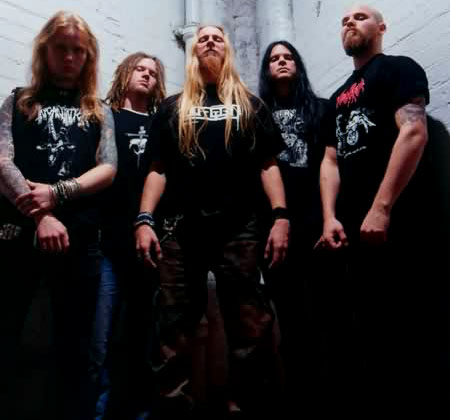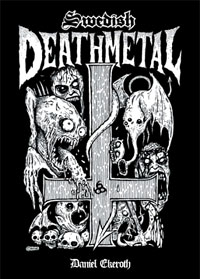When the dust settles on a scene, and its formative years are over, someone needs to chronicle how the people involved got the mental and physical place where they could create that scene. Daniel Ekeroth, bassist of Swedish death metal band Insision, wrote a mighty tome in Swedish Death Metal, a book that appeals to all of us who were ever floored by the founding works of Unleashed, At the Gates, Carnage/Dismember, Nihilist/Entombed, Merciless or Therion.
You bring up the theme of the organic development of (Swedish) death metal a few times in your book, and at one point contrast it directly with the “top-down” method that you assert birthed second-wave black metal. Can you summarize what you see the strengths and weaknesses of these two “approaches” to be with regard to metal/music?
 I’m not sure it has much to do with weaknesses or strengths, it’s just different. As something new grows, you never know what will come next. I guess this is kind of exciting, yet it also means that the next direction might not be your personal taste. But the same goes for the opposite situation, where you start with a formula which then transforms into something you might not expect! Even though second wave black metal started with some “set rules”, or whatever, it kind of changed pretty soon as well. And within a few years some of it was VERY far from what bands like Burzum and Darkthrone was doing in the early 90’s. So I guess everything is constantly in change, and you can never tell what will happen. And if something is to prefer over the other, I think is just a matter of taste.
I’m not sure it has much to do with weaknesses or strengths, it’s just different. As something new grows, you never know what will come next. I guess this is kind of exciting, yet it also means that the next direction might not be your personal taste. But the same goes for the opposite situation, where you start with a formula which then transforms into something you might not expect! Even though second wave black metal started with some “set rules”, or whatever, it kind of changed pretty soon as well. And within a few years some of it was VERY far from what bands like Burzum and Darkthrone was doing in the early 90’s. So I guess everything is constantly in change, and you can never tell what will happen. And if something is to prefer over the other, I think is just a matter of taste.
This dichotomy (top-down/bottom-up) is commonly evoked in political and social theory… Do you think any parallels can be drawn between these different approaches in metal and those at broader scales?
You probably could (you can always do that), but I guess the results would be ad-hoc.
Your book has great detail on the development of Swedish death metal as a closed system, but doesn’t touch a lot on external/social stimuli that may have affected it (outside of the mention of the assassination of Olaf Palme). Is there anything else you’ve considered that may have come into play and that you may not have been able to include in the book?
I think it was a very closed system of a few kids trying to have fun, but the system was scattered around the world (South America, Florida, the UK, Finland, Germany). The conditions in the places all over the world was very different, so I don’t think you should draw to big a conclusion about the climate in Sweden. The main thing in Sweden was probably that we had a good economy, and kids could afford instruments and get rehearsal spaces.
Have you ever read any sociologists’ “outsider” accounts (books) about death and black metal? If so, do you think they are just empty academic exercises or can they offer insight?
I’ve read everything I have found, and it is always fun to read such things. Still, the conclusions is doomed to be guesses. My experience is that metal evolves in very different places, around people with very different backgrounds. Just one example: the Stockholm scene was basically made up by working class kids, whereas the Gothenburg scene was based around kids from the upper middle class.
Your editorial choice to give your personal impression of the bands and music is refreshing, as it helps the reader to understand the subject from a perspective of quality and not necessarily popularity. Were most of your assessments fully honest?
Yes. I think this is the only way to make an interesting read. Still, many opinions are of course colored by the mood I was in when I was listening to the music. Also, I might be suffering from nostalgia in a few instances.
The truth is scandalous. But without it, nothing has any worth. An honest and naive vision of the world is already a masterpiece… As you approach the truth, your solitude will increase.
– Michel Houllebecq, To Stay Alive
Most of the insider commentary gives the impression that this was just a ride for a lot of the participants, that they were swept up in a movement bigger than themselves and simply enjoying it moment-for-moment as it came. Anders Schultz’s statements make this very clear, for one. Was this true for most of those involved, in your view?
It was a very small movement, but it was just great fun to find out a few other guys interested in the same music as you. I guess this is true of just about any underground movement of any kind anywhere. People were very young you know, and most didn’t have any clue at all about the world. Anything you did back then was basically for the hell out of it!
In your experience, is it possible to recapture the mood and creative drive (not the exact feeling) of what occurred in Sweden from 1998-1993 in metal anymore?
Certainly so, but not for old geezers like me. Newer generations will find new ways. But maybe it won’t be metal next time, I couldn’t tell.
You never mention Finnish death metal a single time in your book, though they have always had a vibrant and creative death metal “scene” and sound in their own right. How much musical cross-pollination occured between Sweden and Finland?
I think the scenes operated pretty much independently, nobody I interviewed ever mentioned the Finnish scene very much (and I sure did not know anyone from Finland at the time). The Finnish scene deserves a book on its own, bands like Xysma, Demilich and Demigod sure were fantastic.
Every substance is negatively electric to that which stands above it in the chemical tables, positively to that which stands below it. Water dissolves wood and iron and salt; air dissolves water; electric fire dissolves air, but the intellect dissolves fire, gravity, laws, method, and the subtlest unnamed relations of nature in its resistless menstruum. Intellect lies behind genius, which is intellect constructive. Intellect is the simple power anterior to all action or construction. Gladly would I unfold in calm degrees a natural history of the intellect, but what man has yet been able to mark the steps and boundaries of that transparent essence? The first questions are always to be asked, and the wisest doctor is gravelled by the inquisitiveness of a child. How can we speak of the action of the mind under any divisions, as of its knowledge, of its ethics, of its works, and so forth, since it melts will into perception, knowledge into act? Each becomes the other. Itself alone is.
– Ralph Waldo Emerson, Essays: First Series
Do you think most people overlook AUTOPSY’s influence on the Swedish death metal sound, or is it overstating things to give them a big role?
They were huge in Sweden at the time, and also the first Death album has that same sludgy feeling that would characterize the original Swedish scene. Dismember would certainly not have sounded the way they do without Autopsy.
What three demo-level bands do you think would have made “history” had they recorded an album? I assume CREMATORY is one…
I would say Mefisto, Morbid and Obscurity. If these bands would have made actual records they would be far more recognized these days. But basically, most of the obscure bands from the 80’s would have been highly regarded had they made an album and gotten some attention.

Besides the emergence of black metal, was there anything else that had a ruinous effect on Swedish death metal’s vibrancy?
Age I would say! You know, people got old and faced problems with apartments, jobs, girlfriends, children and everything else concerning adulthood.
What kind of strange things occured in Sweden at the height of the genre’s popularity along the lines of ENTOMBED being featured on cheesy television programs?
Well, not very much to be honest. The “mainstream” thing has certainly been overstated. Apart from a few interviews and articles in tabloids, and the occasional review in the mainstream press, death metal basically remained underground. Black metal actually got far more attention, and was just everywhere in the mid-90’s.
Is Swedish death metal, and music like it, necessarily a youth-based movement?
Well, not any more is it? I guess today it is a genre for 30-40-year-olds. Still, the best albums have generally been made by youngsters, but this is possibly true about most genres.
Regarding youth, you mentioned multiple times in the book the sentiment that the first demo/album by any band is the best output. The fact that this feeling seems more widespread among people who actually have decent taste is enough to convince me that stereotypes are truth-based memes. Can you name some prominent exceptions to this “rule” (not necessarily limited to Swedish death metal)?
Young bands are usually hungry and use up their best riffs and ideas on their first efforts, but of course there are exceptions. Sweden’s Repugnant went out at their best, and a band like Watain is a million times better today than they were on their debut. Voivod’s third and fourth albums are far superior to their first recordings. And Grotesque’s last recording is by far their best to my ears.
What non-metal influences were most heavily represented in Swedish death metal?
Crust Punk, like Discharge. Especially the Stockholm scene was very rooted in extreme punk.
In what directions may it be possible to extend metal in the future without dismantling the essence of it?
 What we need to do is to reclaim the RIFFS! Modern “metal” mainly seems like melodies and harmonies to me, whereas I always thought the riff was the thing that made it metal. Once the riff is back, I guess any direction is open for exploration. Without the riff, I am not sure we can call music metal at all…
What we need to do is to reclaim the RIFFS! Modern “metal” mainly seems like melodies and harmonies to me, whereas I always thought the riff was the thing that made it metal. Once the riff is back, I guess any direction is open for exploration. Without the riff, I am not sure we can call music metal at all…
Have you seen or read the far more obscure book of similar theme and content that was released after yours (Encyclopedia of Svensk DödsMetall)?
I visited him while he was working on it in Padova, and saw a few segments of it. I also helped him to get in contact with some bands. Still, I have not seen the finished product.
What do you strive to achieve with your own bands? Feel free to promote/summarize your musical history.
I just want to play music that I like, and make me feel good about myself. I played in many punk/progressive bands in the 80’s before I got serious with Diskonto (crust punk) and Dellamorte (death crust) around 1994. Then I joind Insision (death) in 1999, and Tyrant (black) in 2007. Today I am only a part of Tyrant, since I can’t find time for anything else. We actually sound very much like my first band, who only did Sodom and Bathory covers, so I guess my circle is closed!
Delve into the subjects that no one wants to hear about. The other side of the scenery. Insist upon sickness, agony, ugliness. Speak of death, and of oblivion. Of jealousy, of indifference, of frustration, of the absence of love. Be abject, and you will be true.
– Michel Houllebecq, To Stay Alive
Swedish death metal, in part through its sustain-heavy “fat sound” (you did a great video explaining this that showed up recently), emphasized the melodic aspects of death metal, giving a canvas for bands like Dismember and At the Gates to make melodic metal music that wasn’t “melodic” in the sense of heavy metal but interpreted it in a uniquely “death metal” style. Did this influence black metal to develop later in a more melodic direction?
I guess Dissection in particular influenced much of that melodic black metal (and death metal!) – what they did was so great. But also, I guess some of that mid-90’s black metal is so based in harmonies and melodies since the band members didn’t come from metal. They didn’t know about the riff! I am really glad for a band like Nifelheim for bringing back the riff, and that whole 80’s heavy metal touch, back into black metal.
Tusen tack för intervjun! Var snäll och påstå några sluta ord här.
Ok, thank you for your attention! I wish you all the best with all your future work!

